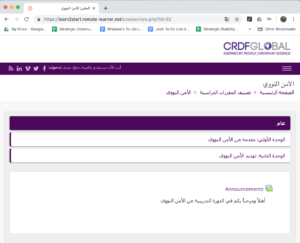July 16, 2019
As a 2018 Robin Copeland Memorial Fellow (RCMF), Dr. Amira Elabd of Egypt spent one semester at CNS and an additional three months in the CNS Washington, DC, office to deepen her understanding of international security policy. For her capstone project, Dr. Elabd developed an online learning course in Arabic focused on the topic of nuclear security. The course is available free of charge and is available through CRDF Global’s Moodle site (log in as guest to access).
“Online learning has really grown over the last few years,” Dr. Elabd said. “Making the material available in Arabic widens the pool of learners who may want to or need to learn about nuclear security, but who may not be able to due to a difference in language.”
Dr. Elabd is an associate professor in analytical chemistry, nuclear safeguards, and physical protection department at the Nuclear and Radiological Regulatory Authority. She is also a member of CNS’s Middle East Next Generation of Arms Control Specialists (MENACS) Network. She holds a PhD in chemistry from Ain Shams University in Cairo.
Dr. Elabd was awarded the Robin Copeland Memorial Fellowship from CRDF Global. The fellowship was made possible by a grant to CRDF Global from the Carnegie Corporation of New York and the Nuclear Threat Initiative. For more information on the Robin Copeland Memorial Fellowship, visit the CRDF Global website.
Each module is divided into five sessions. Each session has a video, presentation, and references, running 7–10 minutes each. The content is based on International Atomic Energy Agency publications, and the English versions of each module has been reviewed by experts from Sandia National Laboratories. Below is an outline of the basic objectives of each session.
Module 1: Introduction to Nuclear Security
Session 1: Introduction
- Why is nuclear security (NS) important?
- Describing the potential consequences associated with a nuclear security event
- Video on Goiânia accident & associated consequences
Session 2: Overview on nuclear security
- The basic concepts of nuclear security
- IAEA guidance and its relation to international instruments
- Definition of nuclear security
- Essential elements of an effective nuclear security regime
Session 3: Threat description
- Define target, nuclear security events, and an adversary; and describe the potential target
Session 4: Risk
- Define nuclear security risk
- Describe the need and the role of risk
- Describe a graded approach
- Describe defence in depth
Session 5: Nuclear security regime
- The requirements for an effective State’s nuclear security regime, including policy (at State and facility level), technology (physical protection functions), and people (nuclear security culture)
Module 2: Nuclear Security Threat
Session 1: Target
- Defining materials and facilities
- Categorization of nuclear material and radioactive sources
Session 2: Adversary
- Describe adversaries’ characteristics (motivation, intention and capability)
- Distinguish between internal and external adversaries
Session 3: Threat assessment
- Describe threat matrix
- Define threat assessment
Session 4: Threat statement/Design Basis Threat (DBT)
- Describe the relationship between a threat assessment and a threat statement
- Describe a Design Basis Threat (DBT) and alternative threat statement
Session 5: Threat based-approach
- Describe Regulatory approach
- Distinguish between performance-based and prescriptive approaches
- Describe how the threat statement is used in application of prescriptive, performance-based, and combined approaches
The project was made possible by a grant from the Carnegie Corporation of New York and the Nuclear Threat Initiative. All the content contained therein is solely the responsibility of the author.

